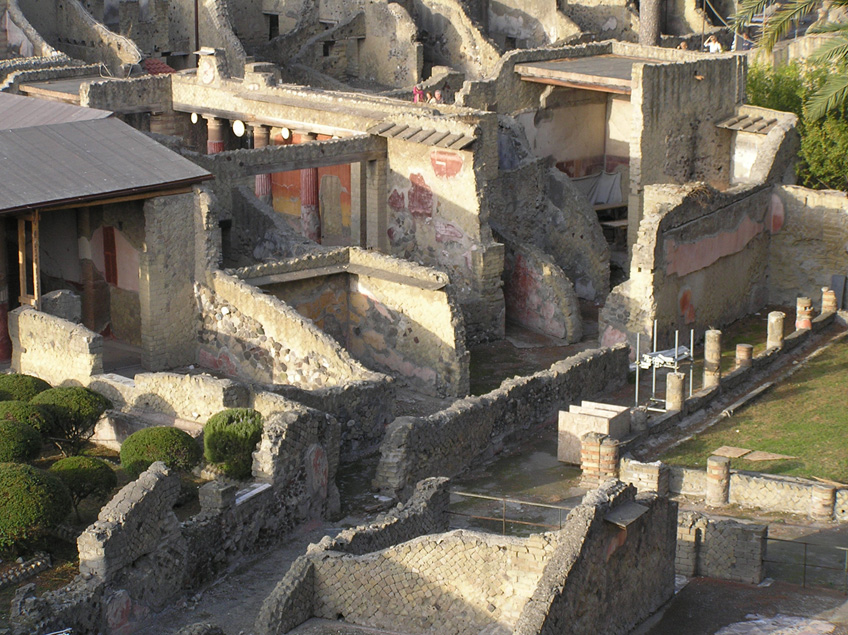
According to the legend, this Greek settlement was founded by Hercules. Whatever the truth of this,it later passed to the Samnites before becoming a Roman town in 89 BC. Twelve kilometres south-east of Napoli, modern Ercolano is a congested, tangled suburb of the city. Ercolano was previously peaceful fishing and port town of about 4000 and something of a resort for wealthy Romans and Campanians.
HistoryThe fate of the city paralleled that of nearby Pompei. Destroyed by earthquake in 63 AD, it was completely submerged in the 79 AD eruption of Vesuvio. The difference was that Ercolano was buried by a river of volcanic mud, not the tufa stone and ash that rained on Pompei. The mud helped preserve it for posterity. When the town was rediscovered in 1709, amateur excavations were carried out intermittently until 1874 and much of the material found was carted off to Napoli to decorate the houses of the well-to-do or to end up in museums. Serious archaeological work was began in 1927 and excavation continues today.
Orientation & InformationErcolano's main street, Via IV Novembre, leads from the Stazione Circumvesuviana, at the modern town's eastern edge, to Piazza Scavi and the main ticket office for the excavations - an easy walk.
The Ruins
The site is divide into 11 insulae (islands) carved up in a classic Roman grid pattern.
From the main entrance and ticket office you follow a path above and around the site, until you arrive at the entrance to the ruins proper in the south-western corner. To leave the site, you must go all the way back to the ticket office. After your tickets have been checked you will probably be gently assailed by would-be guides - if you really want one, make sure you understand what kind of fee or gift is expected at the end. Some of the houses are closed, but an attendant may be able to open them on request. The two main streets, Decumano Massimo and Decumano Inferiore, are crossed by Carlo III, IV and V . On entering , you first encounter Casa Aristide on your left on Cardo III. Immediately next door is Casa di Argo, a well preserved example of a Roman noble family's house, equipped with a garden with a portico, triclinium ( dining area ) and a partly excavated peristyle hall. The most extraordinary mosaic to have survived intact is in the nyphaeum (fountain and bath) in the Casa di Nettuno ed Anfitrite, on Cardo IV. Neptune and Anfitrite are depicted in colours so rich they make you realise what the interior of other well-to-do households must have been like.
If mosaics are your thing, make your way to the city's public baths, Terme del Foro, with separate sections for men and women. The floor mosaics are in pristine condition. While women passed from the apodyterium (changing rooms ; note the naked figure of Triton adorning the mosaic floor) through the tepidarium (warm room) to the caldarium (steam bath), men had the added bracing option of the frigidarium, a cold bath. You can still see the benches where bathers sat and the wall shelves for clothing.
Casa del Atrio Mosaico, an impressive mansion on Carlo IV, also has extensive floor mosaics - time and nature have left the floor uneven to say the least.
Behind it and accessible from Carlo V, Casa dei Cervi ( house of the Deer) is probably the most imposing of the nobles dwellings. The two storey villa, built around a central courtyard, contains various murals and still-life paintings, as well as the marble groups of deer assailed by dogs. In one the rooms stands a statue of a drunken Hercules. On the corner of the Decumano Inferiore and Carlo V is Casa del Gran Portale, named after the elegant brick Corinthian columns that flank its main entrance. Inside are some well preserved wall-paintings.
Off the main street, Decumanus Massimus, is Casa del Bicentenario, sio named because it was excavated 200 years after digging at Ercolano first began. A room upstairs contains a crucifix, indicating that there might have been Christians in the town before 79 AD. As you exit the ruins, to the left along Corso Ercolano, you will the remains of a theatre, dating from the Augustan period.
The archaeological area is open 9 am to one hour before sunset daily in summer, but closes as early as 2.45 pm in winter.